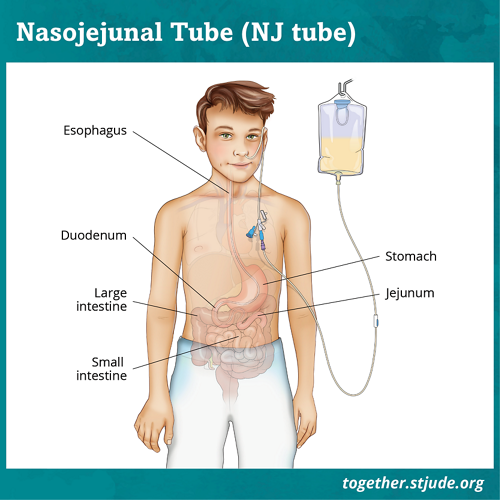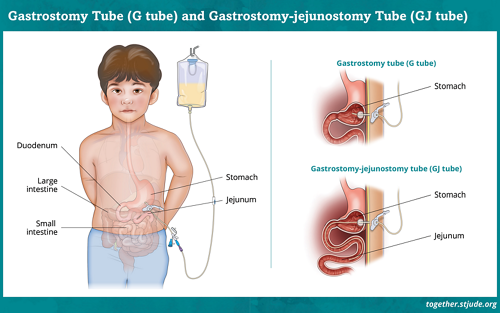Menu
Close
Back
Welcome to
Together is a new resource for anyone affected by pediatric cancer - patients and their parents, family members, and friends.
Learn MoreA feeding tube is a hollow tube used to give liquid nutrition formula or medicines directly into the stomach or the intestine. Your doctor will decide what type of tube is best for your child.
Interventional Radiology (IR) uses imaging such as ultrasound, CT, and X-ray to diagnose and treat cancer and other medical conditions. These tools guide doctors in minimally invasive procedures instead of traditional surgery. By using IR, doctors can help patients have less pain and recover faster.
Nasojejunal tube (NJ tube): This tube passes through the nose, down the throat, through the stomach, and into the intestine. This is usually a short-term solution to feeding problems.
Gastrostomy tube (G tube): This tube passes through a small cut in the skin directly into the stomach. This is a longer-term solution to feeding problems.


Gastrojejunal tube (GJ tube): This tube has 2 parts. The first part passes through a cut in the skin directly into the stomach. The second part passes through the first tube, out of the stomach into the intestine. This is a longer-term solution to feeding problems.
The IR nurse practitioner will meet with you before the procedure to give instructions and answer your questions.
Your child should not have any food or drink for several hours before the tube is placed. The doctor or nurse will give you specific instructions. This includes candy and gum. It is important to follow these instructions, called NPO instructions.
Medicines can be taken with a sip of water up to 1 hour before the procedure.
NJ tube: After the NJ tube is placed, it can be used right away. Most patients do not need to be admitted to the hospital.
G-tube or GJ-tube: After the tube is placed, your child will need stay in the hospital. Clinical Nutrition will order tube feedings. After the tube is placed, your child may not be able to have any food or drink by mouth for the next 6 hours, A dietitian will prescribe a liquid formula based on your child’s nutrition needs. Your child may get some medicines through the feeding tube.
A nurse will teach you how to take care of the feeding tube.
Follow-up visit: The IR nurse practitioner will make a “DI post-procedure” visit for your child. If your child has a G-tube or GJ-tube, the staff will remove the stitches that hold the stomach to the abdominal wall. These stitches are located under three buttons next to the skin. Your child will not need sedation or general anesthesia to have these stitches removed.
To learn more about Interventional Radiology or your child’s feeding tube, please talk to your child’s doctor, nurse, or registered dietitian.
–
Reviewed: August 2022